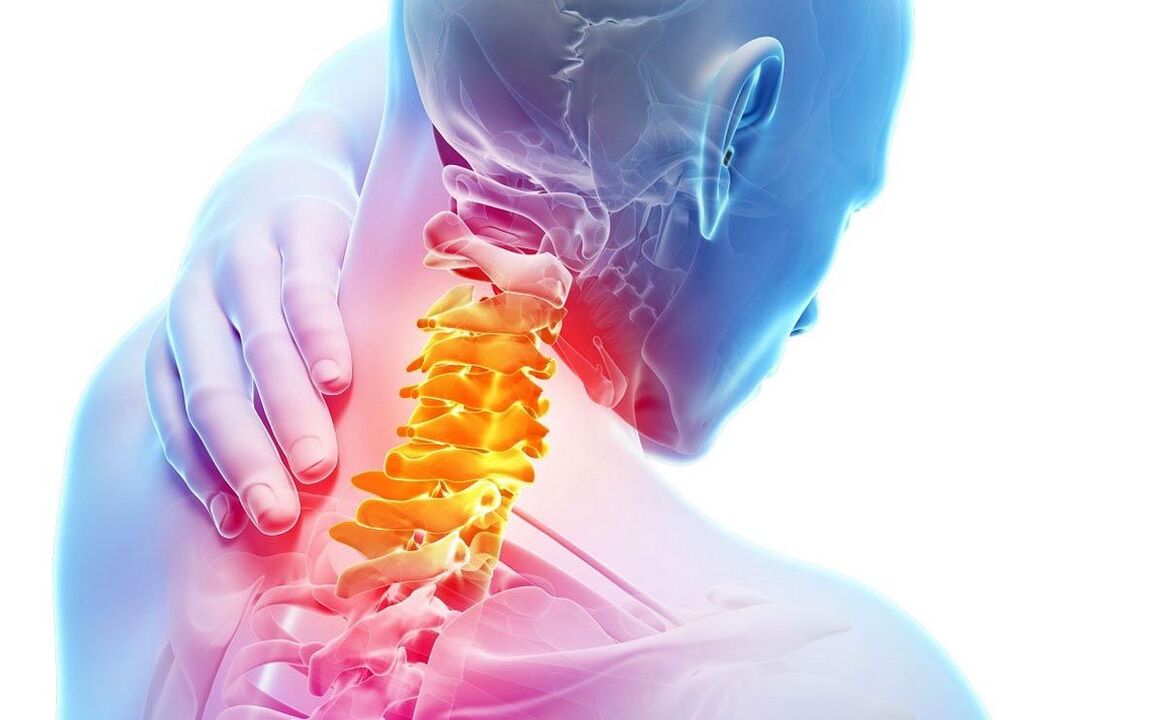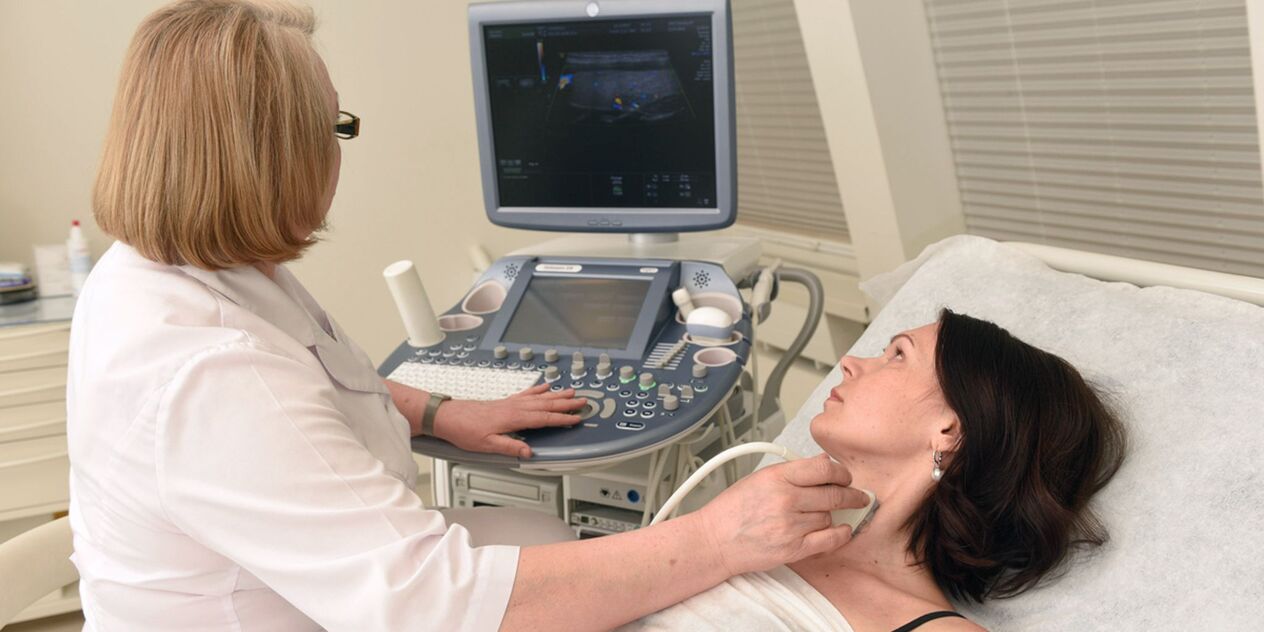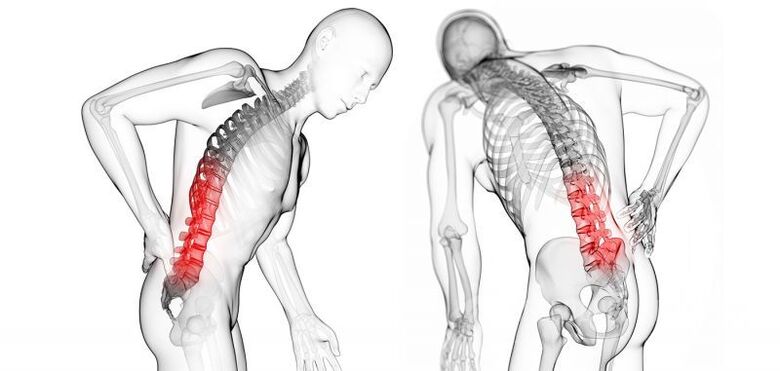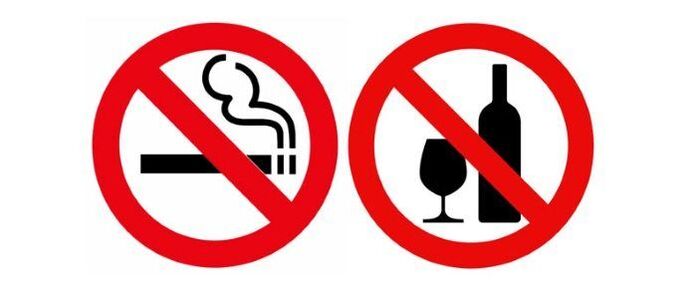Osteochondrosis of the cervical spine is the result of a sedentary lifestyle and poor diet. The first signs of the disease can appear already at the age of 25, and if treatment is not started, severe complications arise. In the treatment of the disease, an integrated approach is used - drug treatment, diet therapy, physical therapy and physiotherapy.

Causes of osteochondrosis of the cervical spine
Cervical osteochondrosis is a degenerative-dystrophic change in the intervertebral discs and joints, which leads to reduced neck mobility and severe pain. The main reason for the development of the disease is a violation of mineral metabolism, due to which bones and joints become less strong. Code MKB-10 – M42, M50–54.
Why does cervical osteochondrosis occur?
- overweight, sedentary lifestyle;
- bad posture, scoliosis;
- rheumatism;
- flat feet;
- VSD;
- poor nutrition.
Injuries, bruises of the spine, excessive physical activity and stress can cause the development of deformation of the cervical vertebrae. In women, osteochondrosis often occurs during pregnancy, menopause - against the background of hormonal changes, the amount of calcium decreases, bone tissue becomes fragile.
Important! The predisposition to osteochondrosis is inherited.
General symptoms and signs
With constant increased load on the cervical vertebrae, muscle spasms occur, the vessels of the cervical spine are squeezed, blood circulation is disturbed, metabolic processes are disrupted - the structure of the intervertebral discs changes, they become deformed and begin to protrude beyond the spinal column.
How is osteochondrosis of the cervical spine manifested:
- radicular syndrome - against the background of compression of the nerve endings, there is pain that spreads from the neck to the shoulder blades, forearms and covers the front wall of the chest;
- muscle weakness in the hands, visible swelling of the neck;
- when you move your head, you hear a characteristic screeching sound;
- weakness, chronic fatigue, changes in blood pressure;
- lack of coordination, often dizziness, attacks accompanied by nausea, vomiting;
- deterioration of vision and hearing, noise, ringing in the ears;
- numbness of limbs, tongue;
- frequent migraines;
- in women aged 45-65, pain, numbness and tingling in the upper extremities occur during sleep, and the attacks can be repeated several times during the night.
In cervical osteochondrosis, nutrition and blood flow to the brain are disrupted, neurotic disorders occur - anxiety, irritability, mood swings, sleep disorders.
Classification of cervical osteochondrosis
As osteochondrosis develops, it goes through several stages of development, each of which has characteristic signs. In the photo you can see how the affected part of the spine looks in different stages.
Degree of disease development:
- Osteochondrosis of the 1st degree - the initial stage occurs without particularly pronounced symptoms, the person suffers from rare and minor pains when turning and tilting the head, the back muscles tire quickly.
- Osteochondrosis of the 2nd degree - the vertebrae become unstable, the nerve is pinched, unpleasant sensations in the neck become pronounced, radiating to the shoulder and arm. Additional symptoms are increased fatigue, frequent headaches in the occipital region, distraction.
- Osteochondrosis of the 3rd degree - the pain becomes chronic, covers the upper part of the back, arms, severe muscle weakness is observed, limbs become numb, intervertebral hernia develops, dizziness attacks often occur.
- Osteochondrosis of the 4th degree - complete destruction of the intervertebral discs occurs, they are replaced by connective tissue, the pathological process covers several segments of the spine. There is a lack of coordination, frequent attacks of dizziness, and tinnitus.

Acute osteochondrosis is a consequence of the chronic form of the disease, which is characterized by a severe attack of sharp pain that occurs suddenly after waking up.
Which doctor should I contact?
If signs of cervical osteochondrosis appear, you should visit a neurologist, some hospitals have a vertebrologist - a specialist who deals with diseases of the spine.
Diagnostic methods
Advanced forms of osteochondrosis have a pronounced clinical picture, which allows the initial diagnosis to be made during the initial examination. Instrumental diagnostic methods will help determine the degree of degenerative changes in the vertebrae.
The main types of examination for osteochondrosis:
- x-ray- the method is effective only in the early stages of the development of the pathology;
- MRI- the structure of bone structures, the size and direction of the development of intervertebral hernias, and the condition of the spinal cord are clearly visible on the screen;
- CT- the method is less effective than MRI, because it does not provide accurate information about the presence and size of the hernia;
- duplex scanning– allows you to see blood flow disorders;
- electroneurography- shows the presence of pinching, inflammation and other nerve damage;
- rheoencephalogram– prescribed for problems with blood supply to the brain.

For a targeted and thorough study of the condition of certain vertebrae, discography is performed - a contrast agent is injected into the intervertebral disc, which allows you to see even the smallest changes in the tissues and distinguish scar changes from hernia.
Methods of treatment of cervical osteochondrosis
In the initial stage of development, osteochondrosis can be cured without medication, it is enough to review the diet, daily routine and regularly perform a set of special exercises. In advanced forms of the disease, effective treatment is possible only with the use of various drugs that help stop degenerative changes in the vertebrae.
The complex of therapeutic measures necessarily includes physical procedures - electrophoresis with drugs, ultrasound, magnetic therapy, laser therapy. These methods help to cope with pain, inflammation, tissue swelling, improve metabolic processes and blood circulation.
First aid
Painkillers will help relieve pain due to osteochondrosis. You can heat the affected area with mustard or a pepper patch.
To reduce swelling of inflamed tissues, drink rosehip decoction and other diuretics. Massaging the inflamed area with an ice cube will help relieve severe neck pain; continue the process until the skin turns slightly red.
Physiotherapy
Exercise therapy is prescribed during the recovery period; during exacerbation of osteochondrosis, physical exercises are contraindicated; gymnastics is simple, you can do it at home and you have to do it regularly.
Bubnovsky's gymnastics for the treatment and prevention of cervical osteochondrosis:
- In a standing position, freely lower your arms to your body. Tilt your head forward, try to reach your chest with your chin, fix the position to the count of 3. Tilt your head back, chin looking up, count to 3. Return to the starting position.
- In a standing position, turn your head to the right, to the left and fix the position at each end point for a few seconds. Repeat 3 times on each side.
- In a standing position, tilt your head to the right, to the left, try to reach your shoulder with your ear and hold the position for 30 seconds. Perform 6 repetitions in each direction.
- Standing, hands on the belt, chin parallel to the floor, stretched forward. Turn your head, rest your chin on your shoulder, turn your torso a little, hold for half a minute. Do 6 reps in each direction; mild pain in the spine may occur.
- In a sitting position, back straight, hands on knees. Extend your straight arms to the sides, move them back a little, at the same time throw your head back, return to the starting position, repeat 5 times.
- In a sitting position, turn your head to the right, place the palm of your left hand on your right shoulder, elbow parallel to the floor, rest your right hand on your knee, return to the starting position. Perform 6 repetitions in each direction.
- In a sitting position, raise your arms above your head, join them well, slightly bend your elbows, turn your head to the side until a slight pain appears, fix the position at the end point for a few seconds. Repeat 6 turns in each direction.
Take a 30-second break between exercises. Before starting gymnastics, you need to take a shower with warm water and make several smooth tilts of the head in different directions to warm up the muscles. After finishing the exercise, gentle stretching will help to avoid discomfort the next day.
Drug treatment
Drug therapy for osteochondrosis is aimed at removing unpleasant sensations, restoring the mobility of the vertebrae and slowing down degenerative changes in the tissues. Acute pain attacks are alleviated with injections of NSAIDs or corticosteroids, while the chronic form of the disease is treated with ointments and tablets.
How to treat osteochondrosis:
- NSAIDs- produced in the form of tablets and products for external use, they remove swelling and pain;
- corticosteroids- alleviate acute pain syndrome;
- B vitamins- restore metabolic processes in tissues;
- chondroprotectors– they encourage the renewal of cartilage tissue;
- drugs to improve blood flow and brain nutrition;
- nootropics- improve brain function and memory;
- muscle relaxants– removes muscle spasms;
- Ointments and gels with anti-inflammatory effects and heating are used for local treatment.
In order for drug therapy to be effective, it must be combined with exercise therapy and follow a diet, otherwise no drugs will help you get rid of osteochondrosis.
Important! If conservative treatment has no effect, surgery is prescribed.
Folk remedies
Traditional treatment should be used as a supplement to drug therapy and physical exercises; unconventional methods will not help to completely get rid of the disease.
What to do with cervical osteochondrosis at home:
- Pour boiling water over a fresh horseradish leaf, cool a little, apply the inner side to the neck, secure with a thin natural cloth. Do the procedure before going to bed, leave the compress all night.
- Grate raw potatoes finely and mix in equal proportions with warm liquid honey. Use the mixture for dressings, perform the procedure 1-2 times a week.
- Mix a raw egg with 100 ml of sunflower oil, 20 ml of vinegar and 20 g of flour, put the mixture in a dark place for 48 hours, remove the film from the surface. Apply the product to the inflamed area before going to bed and store in the refrigerator.
- In May, collect pine buds up to 2 cm long, cut into thin slices and place in a dark glass container. For 1 part of raw materials, take 2 parts of sugar, put the medicine in a dark place for 2 weeks. Drink 5 ml of the mixture three times a day, do not swallow immediately, keep it in your mouth for 2-3 minutes. The course lasts 15-20 days and is repeated 2-3 times a year.
- Grind 150 g of peeled garlic and 400 g of cranberries, put the mixture in a glass container, after 24 hours add 800 ml of honey, mix. Take 5 ml of the medicine three times a day before meals.

A cabbage leaf smeared with honey will help you cope with severe pain and draw out excess salt; attach the compress to the neck with a warm scarf and leave it overnight.
Massage for cervical osteochondrosis
Massage helps to strengthen muscle tone, improve blood circulation in tissues; in severe forms of osteochondrosis, sessions are performed by a specialist. In mild forms of the disease, self-massage will help in prevention - treatment is carried out at home.
Massage technique:
- Warm up your muscles- with both hands run intensively along the back, the side of the neck from top to bottom. Warm-up time: 2 minutes.
- Press the edge of your palm against the bottom of your neck,move in a sliding motion to the area of hair growth, then to the shoulder joints.
- Make circular rubbing movements with the fingertips of both handsin the occipital region from the hairline to the forearms - from the spine to the ears and back.
- Squeeze the neck muscles from the bottom up, then in the opposite direction.
- Caressing from the back of the head to the shoulder blades- performed after each type of exercise.
Important! Do not massage protruding vertebrae, lymph nodes or carotid arteries.
Diet
The purpose of nutrition for osteochondrosis is to provide the body with collagen and proteins; these substances participate in the synthesis of cartilage tissue; they are most abundant in aspic, jello and jello.
| Prohibited products | Authorized products |
|
|
Important! To avoid dehydration of the tissue of the intervertebral disc, it is necessary to drink at least 2. 5 liters of clean non-carbonated water per day.
Possible consequences and complications
In the cervical region, the vertebrae are located close to each other, the height of the intervertebral discs is small, so various complications of osteochondrosis occur even with minor degenerative changes in the bone tissue.
Why is osteochondrosis of the cervical spine dangerous?
- frequent migraine attacks;
- heart rhythm disorders, atherosclerosis;
- protrusion, intervertebral hernia, bony outgrowths of vertebrae;
- serious brain pathologies;
- narrowing of the lumen of the vertebral artery, which leads to the development of VSD, cerebral hypertension and disability;
- spinal stroke.

Important! In advanced osteochondrosis, compression of the spinal cord occurs, which can be fatal.
Contraindications for cervical osteochondrosis
In order to lead a full life with osteochondrosis, it is necessary to avoid actions that can cause pain and aggravation of the disease.
What not to do with cervical osteochondrosis:
- sleep on a very hard or soft mattress, on a high pillow;
- lift weights; if you need to lift something heavy, you should do it with a straight back and bent knees;
- carry a bag on one shoulder;
- when the pathology worsens, make active movements of the head and neck;
- smoke, drink alcohol;
- walk without scarves in cold weather, sit in a draft, near an air conditioner;
- stay for a long time in an uncomfortable position, sitting;
- wear high heels;
- break the neck.

Thermal procedures - heating of compresses, visits to the bathhouse, heating with a blue lamp - can only be done in the remission phase of the disease. During an exacerbation, the heat will relieve the pain only for a short time, but soon the unpleasant sensations will return and the degree of their manifestation will increase.
Disease prevention
To maintain the health of the spine, it is enough to follow simple rules of prevention.
How to avoid cervical osteochondrosis:
- get rid of excess weight;
- do gymnastics every morning, go swimming, yoga, dance;
- spend more time outdoors, morning walks are especially beneficial;
- eat right, control your salt intake, follow your drinking regimen;
- when you work sitting, warm up your neck every hour and pay attention to your posture;
- keep the neck warm;
- get enough sleep, avoid physical, mental and emotional fatigue.
Sleep properly. Only the head, neck and shoulders should rest on the pillow on the mattress, and a small pillow should be placed under the feet. It is better to sleep on your back or in the fetal position, and in case of exacerbation of the disease, only on your side. The mattress is orthopedic, medium hard, the pillow is rectangular, orthopedic, height 15-20 cm. In the correct position of the body in sleep, the spine is straight, there are no deformations in different parts, the muscles are relaxed.
Cervical osteochondrosis is a chronic, slowly progressive disease; signs of the disease do not appear immediately. A competent combination of traditional and folk methods of treatment, gymnastics and nutrition will help to cope with unpleasant symptoms, and simple preventive measures will help to avoid recurrence of the pathology.


























